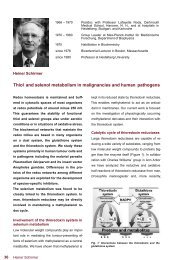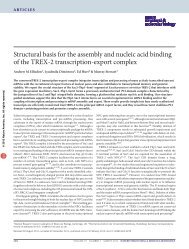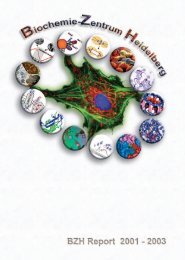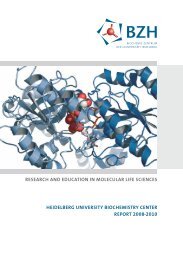Biochemie-Zentrum der Universität Heidelberg (BZH)
Biochemie-Zentrum der Universität Heidelberg (BZH)
Biochemie-Zentrum der Universität Heidelberg (BZH)
You also want an ePaper? Increase the reach of your titles
YUMPU automatically turns print PDFs into web optimized ePapers that Google loves.
Wilhelm Just<br />
Goal<br />
The work of the group focuses on two main<br />
topics (i) mechanisms involved in peroxisome<br />
proliferation and (ii) the physiological role of<br />
ether lipids (ELs) particularly plasmalogens<br />
(PLs), the most abundant EL species in mam-<br />
mals. Studies on peroxisome biogenesis and<br />
functioning are important in terms of both<br />
basic biological un<strong>der</strong>standing of eukaryotic<br />
cells and human pathology.<br />
Background<br />
In the last years we accumulated data indicating<br />
an autonomous division of peroxisomes. To learn<br />
more about the mechanisms implicated in this<br />
process, we initiated experiments to identify the<br />
components involved.<br />
Most functions attributed to PLs thus far were <strong>der</strong>ived<br />
from in vitro experiments. We used the ELdeficient<br />
mouse recently generated in our laboratory<br />
as a promising model to study EL functions<br />
in vivo.<br />
Research Highlights<br />
Ultrastructural analysis of proliferating rat liver<br />
peroxisomes revealed formation of multiple constrictions<br />
in tubular peroxisomes resembling a presegregational<br />
state (Lay D. et al., 2006) (Fig. 1).<br />
16 Wilhelm Just<br />
1970 - 1978 Group lea<strong>der</strong> at the Max-Planck-Institute of Brain Research,<br />
Frankfurt/M.<br />
since 1978 Group lea<strong>der</strong> at the Institute of Biochemistry I / <strong>Biochemie</strong>-<br />
<strong>Zentrum</strong> <strong>der</strong> <strong>Universität</strong> <strong>Heidelberg</strong> (<strong>BZH</strong>)<br />
1987 Habilitation in Biochemistry at the University of <strong>Heidelberg</strong><br />
since 1994 Professor at the <strong>Biochemie</strong>-<strong>Zentrum</strong> <strong>der</strong> <strong>Universität</strong><br />
<strong>Heidelberg</strong> (<strong>BZH</strong>)<br />
Functions and Biogenesis of Peroxisomes<br />
Fig. 1: Peroxisomal constrictions at an early (A) and later<br />
(B) stage of tubulated peroxisomes.<br />
Factors potentially implicated in this process include<br />
various Arf and Rab isotypes, RhoA, actin<br />
and myosin (Lay D. et al., 2005; Wiese S. et al.,<br />
2007) as well as ATP and distinct phosphoinositide<br />
kinases and phosphatases (Jeynov B. et al.,<br />
Fig. 2: Model showing putative sites of action of Arf1/<br />
COPI as well as phosphoinositides, actin, myosin and<br />
dynamin-like protein 1 during vesicular shuttling between<br />
peroxisomes and the ER (Lay, 2006, Lay, 2005) and<br />
peroxisome proliferation (Wiese, Jeynov), respectively.<br />
Alternatively, cycles of Arf/COPI binding and release may<br />
facilitate formation of protein clusters and/or interaction<br />
with the cytoskeleton.







